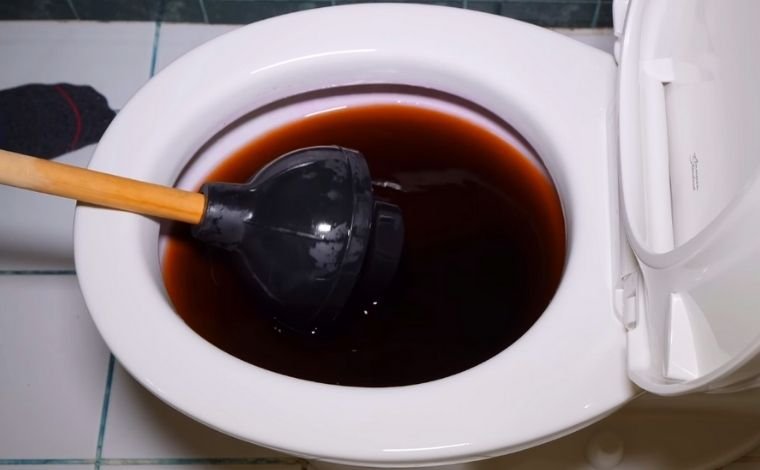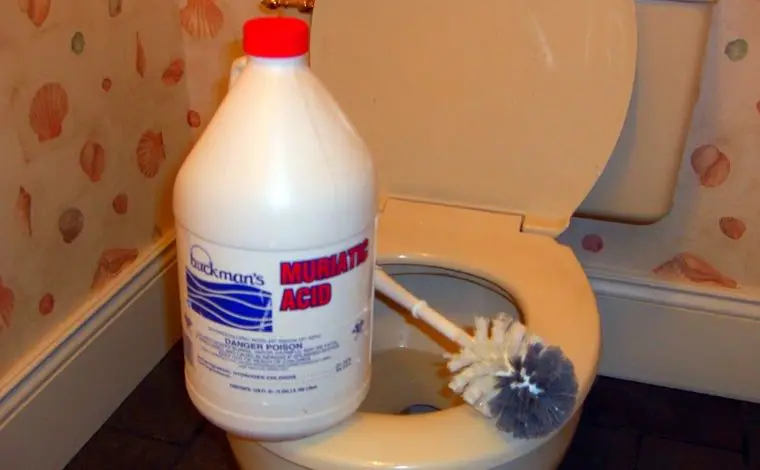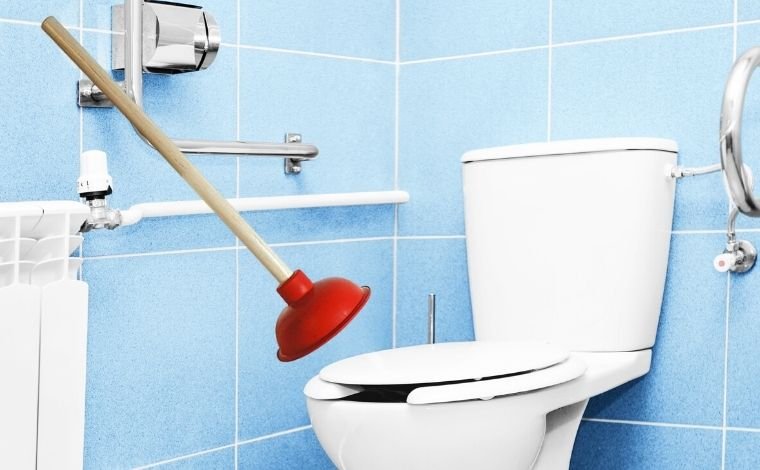A clogged toilet can ruin your morning in seconds. It’s one of those household problems that always seems to happen at the worst possible time. Whether it’s caused by too much tissue, a hidden toy, or an old drain line, unclogging it quickly and safely becomes a top priority.
You may have heard that muriatic acid is an effective way to dissolve stubborn blockages. It’s true that this powerful chemical can clear drains, but it also comes with serious safety concerns. So before pouring anything down your toilet, it’s important to know what you’re dealing with — and how to do it correctly.
In this detailed guide, you’ll learn:
- What causes a toilet to clog
- What muriatic acid is and how it works
- Step-by-step safety instructions
- Environmental and health risks
- Safer, eco-friendly alternatives
- When to call a plumber

Why Toilets Get Clogged So Often
Toilets are designed for one thing — flushing away human waste and toilet paper. Unfortunately, we often treat them like garbage bins, and that’s where the problem starts. Let’s understand the most common reasons behind toilet clogs:
1. Flushing Non-Flushable Items
Paper towels, diapers, wet wipes, cotton balls, makeup pads, sanitary products, and even hair — all of these are non-dissolvable materials. Once flushed, they don’t break down in water and can easily block the trapway or main drain pipe.
2. Kids and Toys in the Toilet
If you have a toddler, you already know this story. Curious kids often drop small toys, pens, or bottle caps into the bowl. These items get stuck in the S-trap or deep inside the drainage line, creating partial or full blockage.
3. Too Much Toilet Paper
Even though toilet paper dissolves in water, using too much of it can still clog the drain — especially in older toilets with weaker flush systems. Excess tissue piles up and prevents proper water flow.
4. Hard Water and Mineral Build-up
In areas with hard water, mineral deposits like calcium and magnesium can accumulate along the pipe walls. Over time, these deposits narrow the pipe’s diameter, slowing the flow of water and waste.
5. Aging or Damaged Plumbing
Old drainage systems often have corroded or cracked pipes that collect waste residue. Tree roots can also penetrate underground lines, creating major blockages that no household cleaner can fix.
What Is Muriatic Acid?
Muriatic acid is a diluted form of hydrochloric acid (HCl). It’s a colorless, highly corrosive solution made by dissolving hydrogen chloride gas in water. In the past, it was known as spirits of salt because it was produced from salt and vitriol (sulfuric acid).
Plumbers and industrial cleaners sometimes use it to remove:
-
Hard water deposits
-
Rust stains
-
Mineral scale inside pipes
-
Concrete residue
However, muriatic acid is not a household cleaner. It’s an industrial-grade chemical that must be handled with extreme care.
How Does Muriatic Acid Work in a Toilet?
When you pour muriatic acid into a toilet bowl (in diluted form), it reacts with organic materials and mineral buildup. The reaction releases heat and gas, which help break down clogs composed of waste, tissue, or scale.
Here’s what happens:
-
The acid contacts the clogging material.
-
It dissolves calcium carbonate, rust, and organic matter.
-
The chemical reaction generates heat.
-
The blockage breaks apart and flows down the drain.
This whole process can take 5–15 minutes, depending on the severity of the clog.
⚠️ Important:
While this sounds effective, muriatic acid can also dissolve the protective glaze of your toilet bowl, corrode pipes, and harm your health if used carelessly.
Safety First: Before You Start
Using muriatic acid is not like using vinegar or baking soda. It’s a dangerous acid, and one drop on your skin or a fume in your nose can cause harm.
Before handling it, follow these essential safety steps:
-
Ventilation: Open all doors and windows in the bathroom. Turn on the exhaust fan if you have one. Acid fumes are toxic.
-
Protective Gear: Wear long gloves, a face mask or respirator, goggles, and old clothing that covers your skin.
-
Avoid Plastic Bowls: Use a glass or chemical-resistant container for mixing.
-
Keep Children and Pets Away: No one else should enter the room while you’re working.
-
Always Read the Label: Follow the manufacturer’s dilution and handling guidelines.
How to Use Muriatic Acid to Unclog a Toilet (Step-by-Step)
Step 1: Prepare the Toilet
If the bowl is full of water, remove some using a small container or sponge. Leave just enough water to cover the trap opening.
Step 2: Dilute the Acid
Never pour muriatic acid directly into the toilet.
Instead, mix 1 part acid with 10 parts water.
👉 Always add acid into water, not the other way around — adding water to acid can cause an explosive reaction.
Example: For one cup (250 ml) of acid, mix it into 2.5 liters of water.
Step 3: Pour Slowly
Gently pour the diluted acid into the toilet bowl. Aim near the drain hole and pour slowly to avoid splashing.
Step 4: Let It React
Leave the solution for 10–15 minutes. You may hear fizzing or bubbling — that’s the acid reacting with the clog. Don’t touch or inhale the fumes.
Step 5: Flush Thoroughly
After the reaction time, flush the toilet several times with cold water. This helps push away dissolved material and rinse out any remaining acid.
Step 6: Neutralize
To make sure no acid remains, pour a baking soda solution (½ cup baking soda + 1 liter water) into the bowl. This neutralizes the leftover acid in the pipes.
Step 7: Final Flush
Flush again 2–3 times. The line should now be clear.
Risks of Using Muriatic Acid in Toilets
Even though muriatic acid can dissolve clogs quickly, it’s not a perfect solution. In fact, it can cause serious long-term problems.
1. Pipe Corrosion
If you have metal or old cast-iron pipes, the acid can eat away at them, leading to leaks or full pipe failure.
2. Porcelain Damage
The glaze on your toilet bowl can become dull, etched, or cracked from acid exposure.
3. Toxic Fumes
Inhaling muriatic acid fumes can burn the nose, throat, and lungs. Even brief exposure can cause coughing, eye irritation, or worse.
4. Environmental Harm
Muriatic acid kills bacteria in your septic system — including beneficial microbes that break down waste. It also pollutes groundwater if not neutralized properly.
5. Dangerous Chemical Reactions
Never mix muriatic acid with bleach or other cleaning agents. The combination releases deadly chlorine gas.
Safer Alternatives to Muriatic Acid
If you’re not comfortable using strong acid (and you shouldn’t be unless you’re experienced), there are plenty of safer ways to unclog a toilet.
1. Plunger
The first and safest method. Create a tight seal and push up and down several times to dislodge the blockage.
2. Drain Snake / Auger
A flexible steel cable that breaks apart or pulls out clogs. Very effective for toys or solid obstructions.
3. Hot Water and Dish Soap
Pour a bucket of hot (not boiling) water mixed with dish soap into the toilet. Wait 15 minutes and flush. The heat and lubrication often break up the blockage.
4. Baking Soda and Vinegar
Pour one cup of baking soda followed by one to two cups of vinegar. Let the fizzing reaction sit for 30 minutes before flushing with hot water.
5. Enzyme-Based Cleaners
Eco-friendly products that use bacteria and enzymes to digest organic waste. Safe for septic systems and regular use.
6. Wet/Dry Vacuum
If you have one, it can suck out the clog or dislodge it with suction. Just be sure to sanitize it afterward.
After Using Muriatic Acid: Cleaning and Neutralizing
If you’ve used acid, you must clean the area properly:
-
Flush the toilet at least three times with plenty of water.
-
Rinse nearby tiles or walls to remove splashes.
-
Pour a baking soda solution down the drain to neutralize leftover acid.
-
Dispose of gloves and wash your hands with soap immediately.
When to Call a Plumber
Even with muriatic acid, some clogs won’t go away — and forcing it may cause more harm than good. You should contact a professional plumber if:
-
The clog doesn’t clear after multiple flushes.
-
You suspect a solid object (toy, razor cap, etc.) is stuck.
-
You hear bubbling or gurgling from other drains.
-
You notice water backing up elsewhere.
-
The toilet leaks or has visible cracks after cleaning.
Professional plumbers use tools like hydro-jet machines and inspection cameras that can clear deep blockages safely.
Final Thoughts: Should You Use Muriatic Acid?
Muriatic acid is a powerful but dangerous chemical cleaner. It can dissolve organic matter, hair, and scale effectively — but at the cost of your safety, plumbing, and environment if misused.
If you’re a beginner, don’t use it yourself. Try mechanical methods or call a plumber.
If you still decide to use muriatic acid:
-
Dilute it properly (1 part acid to 10 parts water)
-
Pour it carefully into the bowl
-
Let it sit for 10–15 minutes
-
Flush several times
-
Neutralize with baking soda
-
Ventilate thoroughly
Remember, prevention is always better than cure. Avoid flushing anything except waste and toilet paper, and you’ll rarely need to deal with clogs again.
Hi, this is Robert Crossan, the owner of this website, has 17 years of experience in the installation, maintenance, and repair of toilets and plumbing systems. After completing the Level 2 Basic Plumbing course in 2005, I started working in both domestic and commercial buildings as a professional plumber. So I can figure out the core difference between different toilet models and brands. It also helped me monitor their work performance and setbacks.